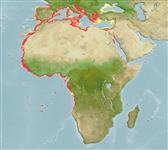Common names from other countries
Пластиножаберные (акулы и скаты) (sharks and rays) >
Torpediniformes (Electric rays) >
Torpedinidae (Electric rays)
Etymology: Torpedo: Latin, torpere = be sluggish (Ref. 45335).
More on author: Linnaeus.
Environment: milieu / climate zone / depth range / distribution range
экология
морской демерсальный; пределы глубины 2 - 400 m (Ref. 4430), usually ? - 70 m (Ref. 27000). Deep-water; 48°N - 18°S, 19°W - 38°E (Ref. 114953)
Eastern Atlantic: southern Bay of Biscay and throughout the Mediterranean to Angola. Most common in tropical waters.
Size / Вес / Возраст
Maturity: Lm ? range ? - ? cm
Max length : 60.0 cm TL самец/пол неопределен; (Ref. 13417); 41.0 cm TL (female); common length : 30.0 cm TL самец/пол неопределен; (Ref. 13417); common length :39 cm TL (female)
Found on soft bottoms, usually inshore but occasionally deeper. Feeds on small fishes and also benthic invertebrates. Ovoviviparous, with 3-21 in a litter (Ref. 12951, Ref. 114953). Size at birth 9 cm (Ref. 12951). Capable of inflicting a severe shock of up to 200 volts.
Life cycle and mating behavior
Maturities | размножение | Spawnings | Egg(s) | Fecundities | личинки
Exhibit ovoviparity (aplacental viviparity), with embryos feeding initially on yolk, then receiving additional nourishment from the mother by indirect absorption of uterine fluid enriched with mucus, fat or protein through specialised structures (Ref. 50449).
Bauchot, M.-L., 1987. Raies et autres batoides. p. 845-886. In W. Fischer, M.L. Bauchot and M. Schneider (eds.) Fiches FAO d'identificationpour les besoins de la pêche. (rev. 1). Mèditerranée et mer Noire. Zone de pêche 37. Vol. II. Commission des Communautés Européennes and FAO, Rome. (Ref. 3261)
Статус Красного Списка МСОП (Ref. 130435)
CITES (Ref. 128078)
Not Evaluated
Использование человеком
рыболовство: интереса не представляет; аквариум: общественные аквариумы
дополнительная информация
инструменты
Специальные отчеты
Скачать в формате XML
ресурсы в Интернет
Estimates based on models
Preferred temperature (Ref.
115969): 13 - 20.9, mean 15.6 (based on 78 cells).
Phylogenetic diversity index (Ref.
82804): PD
50 = 0.5005 [Uniqueness, from 0.5 = low to 2.0 = high].
Bayesian length-weight: a=0.01514 (0.01155 - 0.01983), b=2.95 (2.87 - 3.03), in cm Total Length, based on LWR estimates for this species (Ref.
93245).
Trophic level (Ref.
69278): 4.5 ±0.0 se; based on diet studies.
устойчивость к внешним воздействиям (Ref.
120179): низкий, минимальное время удвоения популяции 4.5-14 лет (K=0.11).
Fishing Vulnerability (Ref.
59153): High to very high vulnerability (65 of 100).
